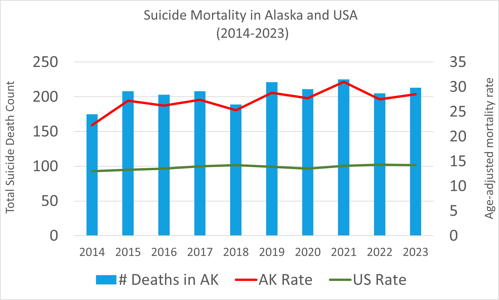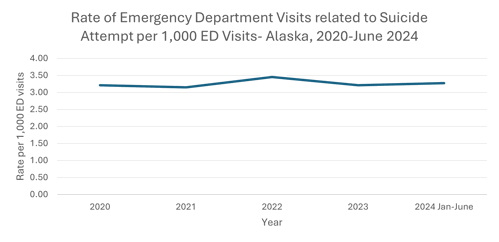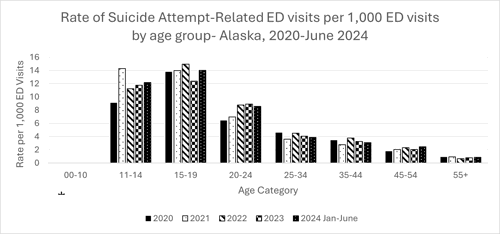Alaska Suicide Facts & Statistics
View public reports on suicide statistics in Alaska
Overview
Find reports and statistics on suicide in Alaska, with official numbers updated each fall for the previous year.
Facts and data
This data is collected from Alaska Health Analytics, Vital Records, and U.S. CDC.
The graph below shows that Alaska’s suicide mortality rates are much higher than US rates and have a slightly increasing trend line since 2014.

The morbidity data in the 2 graphs below are from the Division of Public Health, Syndromic Surveillance Epidemiology Section.


Statewide data resources
Data dashboards are interactive tools for visualizing data, updated regularly.
- Alaska Health Analytics and Vital Records Section (HAVRS) maintains two dashboards:
- Alaska Discharge Dashboard
- Alaska Death Dashboard
- Alaska Youth Risk Behavior Survey (YRBS) The YRBS is a biannual school survey of Alaska high school students, collecting data on health behaviors, mental health crises, and suicidal ideation. The YRBS dashboard allows users to view results by school type, health variable, and trends over time.
- The BRFSS is an annual phone survey of Alaska adults on health and behaviors like nutrition, exercise, and substance use. Data supports public health programs, federal grants, and resource planning. Results are weighted for population estimates, and regional data is provided when sample sizes allow.
- The ACEDRC is a tool that provides data on ACEs (Adverse Childhood Experiences) and PCEs (Protective Childhood Experiences) in Alaska
Data reports
- Division of Behavioral Health, Section of Prevention and Early Intervention Alaska Suicide Data Summary Report: This quarterly report includes data on suicide deaths (HAVRS), suicide attempts (Syndromic Surveillance), and crisis call center activity (Careline and Crisis Services). This information is updated quarterly. For access to this report, email sheli.delaney@alaska.gov or eric.morrison@alaska.gov
- 2023 Alaska Scorecard: Key Issues Impacting Alaska Mental Health Trust BeneficiariesThis tool measures population health outcomes for Alaska Mental Health Trust beneficiaries, as outlined in Strengthening the System: Comprehensive Integrated Mental Health Program Plan 2020-2024.
Data platforms
- Alaska Maternal and Child Death Review (MCDR) Reviews deaths of pregnant individuals, infants, and children to identify causes and make prevention recommendations
- Syndromic Surveillance Monitors emergency department data to quickly identify suicide clusters or spikes. Data on suicide-related hospital visits is included in the Alaska Suicide Data Summary Report
- Alaska Violent Death Reporting System (AKVDRS) Collects data on violent deaths, reconciling information from multiple sources to analyze contributing factors
- Alaska Health Analytics and Vital Records Section (HAVRS) Publishes annual and special reports on deaths by suicide, traumatic brain injuries, and drug overdoses, along with interactive dashboards
- Alaska Youth Risk Behavior Survey (YRBS) A biannual survey of Alaska high school students that tracks health behaviors, mental health, and suicidal ideation
Strategic plans
- Strengthening the System: Alaska’s Comprehensive Integrated Mental Health Program PlanAlaska’s five-year mental health program plan addressing nine priority areas, including suicide prevention
- Messages of Hope: Alaska’s Statewide Suicide Prevention Plan 2023-2027 The five-year suicide prevention plan offers strategies, recommendations, and resources to guide statewide suicide prevention efforts, empower communities, and provide referral information for services, support, and crisis care. It meets the statutory requirement under AS 44.29.305.
- Healthy AlaskansThe statewide health improvement plan includes goals and data on mental health, protective factors, and suicide prevention
Regional data reports
The following publications help us understand if important services are easy to access in each community listed:
- Kenai Community Needs Assessment
- Metlakatla Community Needs Assessment
- Behavioral Health Roadmap Project for Alaska’s Youth Specifically looks at services for youth behavioral health needs for Interior, Northern, Southeast, Southcentral, and Southwest Alaska
Resources
Related Services
Other Relation Education
Related Organizations
Contact us
Statewide Suicide Prevention Council
Eric Morrison, Assistant
431 North Franklin Street, Suite 200
Juneau, Alaska 99801
Office: (907) 465-8920
Toll free: 1 (888) 464-8920Fax: (907) 465-4410